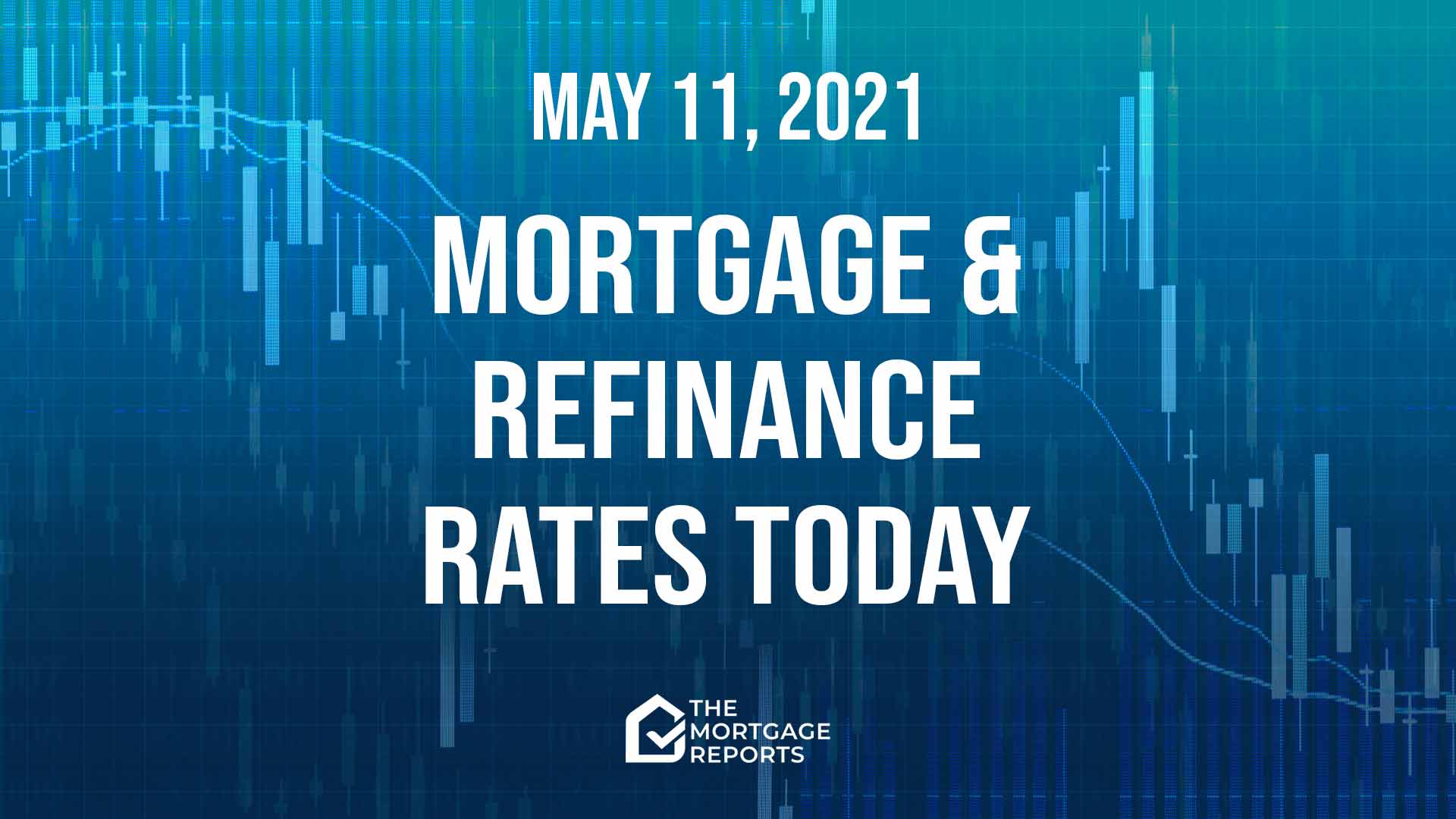
Today’s mortgage and refinance rates
Average mortgage rates just inched higher yesterday. So the sharper increase I warned might happen didn’t materialize. However, it remains a risk.
Indeed, first thing this morning, movements in key markets were suggesting mortgage rates may rise modestly again today.
Find and lock a low rate (May 11th, 2021)Current mortgage and refinance rates
| Program | Mortgage Rate | APR* | Change |
|---|---|---|---|
| Conventional 30 year fixed | |||
| Conventional 30 year fixed | 2.98% | 2.985% | Unchanged |
| Conventional 15 year fixed | |||
| Conventional 15 year fixed | 2.188% | 2.305% | Unchanged |
| Conventional 20 year fixed | |||
| Conventional 20 year fixed | 2.75% | 2.842% | Unchanged |
| Conventional 10 year fixed | |||
| Conventional 10 year fixed | 1.998% | 2.192% | +0.21% |
| 30 year fixed FHA | |||
| 30 year fixed FHA | 2.745% | 3.402% | +0.06% |
| 15 year fixed FHA | |||
| 15 year fixed FHA | 2.463% | 3.064% | +0.01% |
| 5 year ARM FHA | |||
| 5 year ARM FHA | 2.5% | 3.194% | Unchanged |
| 30 year fixed VA | |||
| 30 year fixed VA | 2.375% | 2.547% | +0.03% |
| 15 year fixed VA | |||
| 15 year fixed VA | 2.25% | 2.571% | Unchanged |
| 5 year ARM VA | |||
| 5 year ARM VA | 2.5% | 2.372% | Unchanged |
| Rates are provided by our partner network, and may not reflect the market. Your rate might be different. Click here for a personalized rate quote. See our rate assumptions here. | |||
COVID-19 mortgage updates: Mortgage lenders are changing rates and rules due to COVID-19. To see the latest on how coronavirus could impact your home loan, click here.
Should you lock a mortgage rate today?
We’re yet to see the consistent rises in mortgage rates that I’ve been anticipating. But I’m still pretty sure they’re on their way. Read on for my reasons.
Meanwhile, last Friday’s appreciable fall means these rates were yesterday morning at their lowest point for several weeks and are almost unchanged today. So I’d lock now.
But, of course, you may reject my analysis. If you think further falls are likely, you can continue to float.
Still, my personal rate lock recommendations remain:
- LOCK if closing in 7 days
- LOCK if closing in 15 days
- LOCK if closing in 30 days
- LOCK if closing in 45 days
- LOCK if closing in 60 days
But I don’t claim perfect foresight. And your personal analysis could turn out to be as good as mine — or better. So you might choose to be guided by your instincts and your personal tolerance for risk.
Market data affecting today’s mortgage rates
Here’s a snapshot of the state of play this morning at about 9:50 a.m. (ET). The data, compared with roughly the same time yesterday, were:
- The yield on 10-year Treasurys rose to 1.63% from 1.57% (Bad for mortgage rates.) More than any other market, mortgage rates normally tend to follow these particular Treasury bond yields, though less so recently
- Major stock indexes were appreciably lower on opening. (Good for mortgage rates.) When investors are buying shares they’re often selling bonds, which pushes prices of those down and increases yields and mortgage rates. The opposite happens when indexes are lower
- Oil prices fell to $64.37 from $64.96 a barrel. (Good for mortgage rates*.) Energy prices play a large role in creating inflation and also point to future economic activity.
- Gold prices decreased to $1,822 from $1,844 an ounce. (Bad for mortgage rates*.) In general, it’s better for rates when gold rises, and worse when gold falls. Gold tends to rise when investors worry about the economy. And worried investors tend to push rates lower
- CNN Business Fear & Greed index — Dropped to 45 from 58 out of 100. (Good for mortgage rates.) “Greedy” investors push bond prices down (and interest rates up) as they leave the bond market and move into stocks, while “fearful” investors do the opposite. So lower readings are better than higher ones
Caveats about markets and rates
Before the pandemic and the Federal Reserve’s interventions in the mortgage market, you could look at the above figures and make a pretty good guess about what would happen to mortgage rates that day. But that’s no longer the case. We still make daily calls. And are usually right. But our record for accuracy won’t achieve its former high levels until things settle down.
So use markets only as a rough guide. Because they have to be exceptionally strong or weak to rely on them. But, with that caveat, so far mortgage rates today look likely to edge higher. And be aware that intraday swings (when rates change direction during the day) are a common feature right now.
Find and lock a low rate (May 11th, 2021)
Important notes on today’s mortgage rates
Here are some things you need to know:
- Typically, mortgage rates go up when the economy’s doing well and down when it’s in trouble. But there are exceptions. Read ‘How mortgage rates are determined and why you should care
- Only “top-tier” borrowers (with stellar credit scores, big down payments and very healthy finances) get the ultralow mortgage rates you’ll see advertised
- Lenders vary. Yours may or may not follow the crowd when it comes to daily rate movements — though they all usually follow the wider trend over time
- When daily rate changes are small, some lenders will adjust closing costs and leave their rate cards the same
- Refinance rates are typically close to those for purchases. But some types of refinances are higher following a regulatory change
So there’s a lot going on here. And nobody can claim to know with certainty what’s going to happen to mortgage rates in coming hours, days, weeks, or months.
Are mortgage and refinance rates rising or falling?
Today and soon
Yesterday, we explored how a fear of future inflation could push mortgage rates higher. But they may rise even if those fears remained subdued. That’s because mortgage rates almost invariably increase as the economy warms up. And ours looks set to run hot this year.
Also yesterday, Comerica Bank published its US Economic Outlook for May. And it began:
The parade of positive U.S. economic data over the last month has been astonishing. Several series hit either alltime highs or multi-decade highs.
True, that publication went on to explore risks to the recovery. But the most notable of those was future inflation.
Yes, the other areas it discussed (mainly supply chain bottlenecks) could slow the current recovery. But, as Comerica pointed out, “Demand is so strong in so many industries that supply chains are straining to keep up.That is a much better problem to have than too weak demand.”
Most serious threat
Of course, there are other risks that might yet kill off the recovery completely. The most obvious is the possibility of a SARS-CoV-2 (the virus that causes COVID-19) variant that is better at resisting vaccines. And, ominously, Nature magazine today reported on the situation in India, observing:
Evidence is growing that one variant first detected in India might be more transmissible and slightly better at evading immunity than existing variants. Animal models also hint that it might be able to cause more severe disease. Researchers want to know if this variant and others might be driving the second wave and what kind of danger they pose globally.
— Nature, “Coronavirus variants are spreading in India — what scientists know so far,” May 11, 2021
Of course, nobody should shrug off these threats. But, right now, a full recovery and boom look the likeliest scenario for the US for the rest of this year. And, as long as that remains the case, rising mortgage rates look highly probable — at least to me.
For more background, check out our latest weekend edition of this report.
Recently
Over much of 2020, the overall trend for mortgage rates was clearly downward. And a new, weekly all-time low was set on 16 occasions last year, according to Freddie Mac.
The most recent weekly record low occurred on Jan. 7, when it stood at 2.65% for 30-year fixed-rate mortgages. But then the trend reversed and rates rose.
However, those rises were mostly replaced by falls in April, though those have moderated since the middle of that month. Freddie’s May 6 report puts that weekly average at 2.96% (with 0.6 fees and points), down from the previous week’s 2.98%. But note how small these weekly movements now are.
Expert mortgage rate forecasts
Looking further ahead, Fannie Mae, Freddie Mac and the Mortgage Bankers Association (MBA) each has a team of economists dedicated to monitoring and forecasting what will happen to the economy, the housing sector and mortgage rates.
And here are their current rates forecasts for the remaining quarters of 2021 (Q2/21, Q3/21, Q4/21) and the first quarter of 2022 (Q1/22).
The numbers in the table below are for 30-year, fixed-rate mortgages. Freddie’s were updated on April 14, Fannie’s on April 12 and the MBA’s on April 22.
| Forecaster | Q2/21 | Q3/21 | Q4/21 | Q1/22 |
| Fannie Mae | 3.2% | 3.3% | 3.4% | 3.5% |
| Freddie Mac | 3.2% | 3.3% | 3.4% | 3.5% |
| MBA | 3.4% | 3.6% | 3.7% | 3.9% |
However, given so many unknowables, the current crop of forecasts might be even more speculative than usual. But, if any of those forecasts are to be proved right, rates will at some point have to rise quickly during the remaining seven weeks of the current quarter (Q2).
Find your lowest rate today
Some lenders have been spooked by the pandemic. And they’re restricting their offerings to just the most vanilla-flavored mortgages and refinances.
But others remain brave. And you can still probably find the cash-out refinance, investment mortgage or jumbo loan you want. You just have to shop around more widely.
But, of course, you should be comparison shopping widely, no matter what sort of mortgage you want. As federal regulator the Consumer Financial Protection Bureau says:
Verify your new rate (May 11th, 2021)Shopping around for your mortgage has the potential to lead to real savings. It may not sound like much, but saving even a quarter of a point in interest on your mortgage saves you thousands of dollars over the life of your loan.



